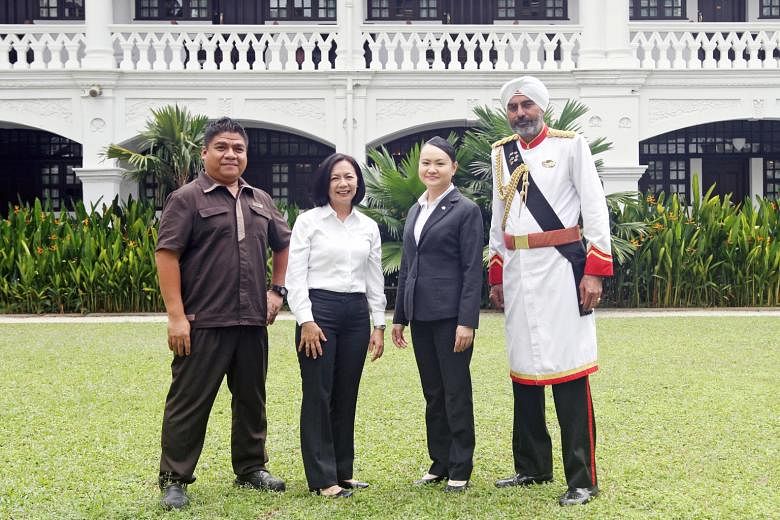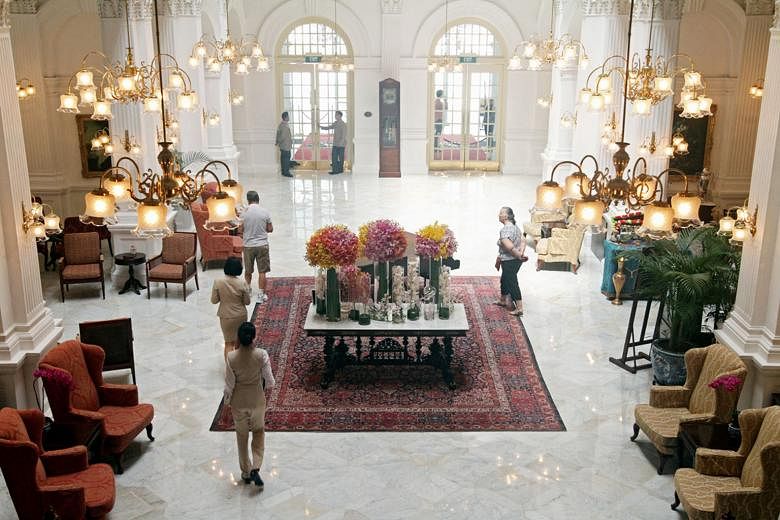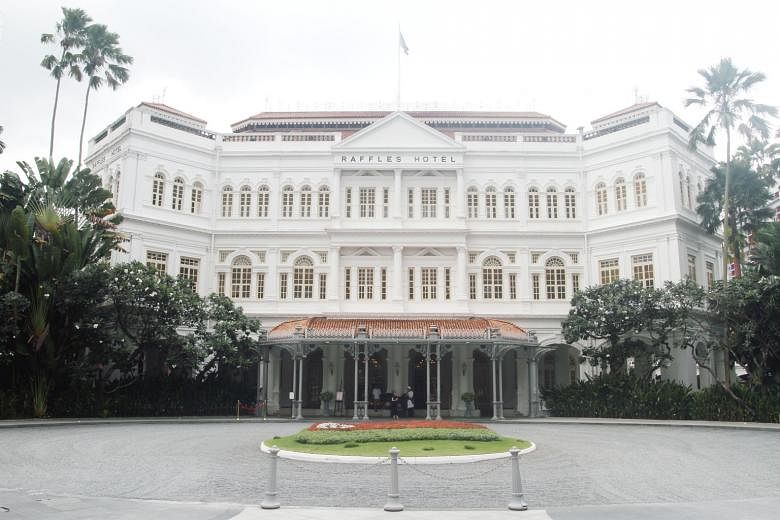Every day without fail, a man with a can of white paint in one hand and a paintbrush in the other will make his rounds along the exterior of Raffles Hotel.
Any hint of discolouration or dirt on the hotel's walls and columns will be promptly painted over if it cannot be cleaned away.
Doing so will ensure the pristine whiteness of the grande dame.
But it is not just any white paint. It has to be Nippon Paint Super Vinilex BS00E55 White.
"Because this building is a national monument, there is nothing we can touch to alter the face of the building, especially its colour, so it is white 365 days a year," said Mr Samsol Misbah, 44, the assistant chief engineer at Raffles Hotel.
The hotel's team of four contracted painters are supervised by the engineering department. They are just a few of the many faces working behind the scenes to preserve the grandeur of the colonial-era hotel.
Opened in 1887, Raffles Hotel has evolved from a 10-room hotel housed within an old bungalow at the corner of Beach Road and Bras Basah Road, to having celebrities and distinguished heads of state staying within its premises.
Among the notable guests who stayed there were the late pop star Michael Jackson, fashion designer Karl Lagerfeld, and the Duke and Duchess of Cambridge, Prince William and Kate Middleton.
Right from the hotel's early days, its founders, the Armenian Sarkies brothers, personally oversaw its expansion projects.
These include the addition of 22 suites in 1890, the construction of the main building in 1899, and the establishment of the Bras Basah wing in 1904.
The hotel has been owned by Katara Hospitality, a hotel developer based in Qatar, since 2011.
Over the years, the deliberate care that goes into the upkeep of the 130-year-old hotel, gazetted as a national monument by the Government in 1987, has allowed it to remain iconic and popular.
For Mr Misbah, who first joined the hotel as a junior technician in 1995, the rich history of the building is also a challenge.
"There's a lot of antique and very old spare parts around the hotel that need to be replaced, but it's hard to find them at local suppliers," he said.
And some of the overseas suppliers no longer exist.
-
The rise and rise of historic hotel
-
•1887: Opens as a 10-room hotel.
•1894: Palm Court wing opens.
•1899: Main building opens.
•1904: Bras Basah wing opens.
•1907: Bar and billiard room is enlarged and remodelled.
•1913: A cast iron veranda is added to the front of the main building.
•1920: An airy ballroom replaces the veranda.
•1987: Hotel is designated as a national monument.
•1989: Hotel is closed for a $160 million complete restoration.
•1991: Restored hotel reopens its doors to the public; Raffles Hotel Arcade opens.
•1992: Hotel officially commemorates its title as a national monument with a plaque.
•1996: Bras Basah wing re-establishes as Raffles Inc, which houses state-room suites.
•2016: Hotel announces a careful and sensitive phased restoration programme, with a grand reopening slated for mid-2018.
Yap Li Yin
For example, there are no replacements or spare parts for the 26-year-old chandelier at the hotel's main entrance, which is originally from England.
Added Mr Misbah: "We have to be creative and find alternatives such as fabricating the exact same piece, and accomplishing that is very satisfying."
Many of the items at the hotel also have historical significance.
For example, the silver beef trolley that is still in use at the Raffles Grill restaurant today was buried in the Palm Court by hotel staff just hours before Singapore fell to the Japanese in 1942.
During the Japanese Occupation, Raffles Hotel was renamed Syonan Ryokan, or Light of the South Hotel.
The silver beef trolley was retrieved only after the war was over.
The hotel is also famous for its hospitality. Upon arrival, guests will be greeted and ushered by liveried Sikh doormen.
One of them, Mr Narajan Singh, 63, is believed to be the most photographed employee of the hotel.
He responded to a recruitment advertisement in a newspaper 25 years ago, which sought someone who was "at least 1.9m" and "Sikh".
Madam Joey Chea, a restaurant senior captain, has been with the hotel since 1992.
The 52-year-old "never gets bored or tired" of taking orders for the famous Singapore Sling, a pink-hued gin-based beverage often garnished with a slice of pineapple and a cherry.
Many claim the cocktail was created in 1915 at the hotel's Long Bar by bartender Ngiam Tong Boon.
Today, the drink remains the bestseller among visitors.
Said Madam Chea: "I had one customer drink five glasses at one go."
She said some guests would also turn up in the morning at the Long Bar just to see peanut shells being tossed onto the floor - a tradition with unclear beginnings.
"We would have swept it up the previous night and I will tell them to come back in the afternoon, when they can see a lot of the shells on the floor," said Madam Chea.
Malaysian Serene Lim, 33, a food and beverage operations manager, first saw the building in 1998 when she was in Singapore for a holiday.
"It was so beautiful and I was mesmerised by the architecture," said Ms Lim, who returned to Singapore in 2003 to work at Goodwood Park Hotel.
However, her heart remained at Raffles Hotel, and she constantly kept a lookout for vacancies.
In 2005, Raffles Hotel offered her a position as a waitress, which she took up without hesitation, even though she was already a senior waitress at Goodwood Park Hotel.
"People here are nice and warm, and the hotel is just like a second home," she said.



